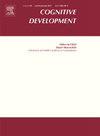Common ground without copresence: Preschoolers apply indirect cues about shared knowledge in real-time referential interpretation
IF 1.8
3区 心理学
Q3 PSYCHOLOGY, DEVELOPMENTAL
引用次数: 0
Abstract
We examined whether, in the absence of physical cues about a speaker’s visual perspective, 4- and 5-year-old children (N = 46) children would use their beliefs about the speaker’s knowledge state to guide real-time referential interpretation. Using a modified version of the visual world paradigm where a speaker provided referential instructions remotely from a different room from the child listener, children learned that some images on their display (i.e., items that appeared on top of blue cards) could not be seen on the speaker’s display (i.e., the speaker saw a blank blue card only). Results indicated that children identified a target referent faster and more accurately when they believed they had privileged access to a competitor object in a visual display versus when they believed this competitor was also known to the speaker. These findings indicate that preschoolers do not require the co-presence of a speaker or immediate line-of-sight cues to rapidly integrate perspective information during real-time language processing. Overall, the findings provide new insights into the different types of perspective cues that children use to guide language understanding, as well as the time course and magnitude of their effects.
没有共同基础的共同基础:学龄前儿童在实时参考解释中使用关于共同知识的间接线索
我们研究了在没有关于说话者视觉视角的物理线索的情况下,4岁和5岁的儿童(N = 46)是否会使用他们对说话者知识状态的信念来指导实时参考解释。使用视觉世界范式的修改版本,说话者在与儿童听众不同的房间远程提供参考指令,儿童了解到他们显示器上的一些图像(即出现在蓝色卡片顶部的物品)在说话者的显示器上无法看到(即,说话者只看到一张空白的蓝色卡片)。结果表明,当儿童认为自己在视觉显示中有特权接触到竞争对手物体时,他们识别目标指称的速度更快、更准确,而当他们认为说话者也知道这个竞争对手物体时,他们的识别速度更快、更准确。这些发现表明,在实时语言处理过程中,学龄前儿童不需要说话人的共同存在或直接的视线提示来快速整合视角信息。总的来说,这些发现为儿童用来指导语言理解的不同类型的视角线索,以及它们的影响的时间过程和程度提供了新的见解。
本文章由计算机程序翻译,如有差异,请以英文原文为准。
求助全文
约1分钟内获得全文
求助全文
来源期刊

Cognitive Development
Multiple-
CiteScore
3.20
自引率
5.60%
发文量
114
期刊介绍:
Cognitive Development contains the very best empirical and theoretical work on the development of perception, memory, language, concepts, thinking, problem solving, metacognition, and social cognition. Criteria for acceptance of articles will be: significance of the work to issues of current interest, substance of the argument, and clarity of expression. For purposes of publication in Cognitive Development, moral and social development will be considered part of cognitive development when they are related to the development of knowledge or thought processes.
 求助内容:
求助内容: 应助结果提醒方式:
应助结果提醒方式:


